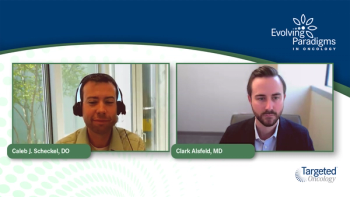
Options for Second-Line Treatment in Relapsed/Refractory Diffuse Large B-Cell Lymphoma
Dr Laurie Sehn reviews the NCCN guidelines for second-line therapy in relapsed/refractory diffuse large B-cell lymphoma and discusses the clinical trial data for a recently approved new treatment combination.
Episodes in this series

Laurie Sehn, MD: What about patients with relapsed/refractory disease? What are their treatment options? We’re talking about a man who’s not considered a transplant candidate, so we’re not going to go down the route of platinum-based chemotherapy with the intent to go to transplant. But the good news is that we do have a lot of treatment options for these patients.
Historically, we used to rely on chemotherapy for these patients. Perhaps not full-blown salvage cisplatin-based therapy, but maybe a bit of a compromise with agents that were more tolerable, with the goal of trying to get some disease control and maintain some quality of life. Unfortunately, we know that most of the chemotherapy-immunotherapy that we would use in the second line setting offers some temporary benefit, but we rarely saw patients have durable disease control. Most of us are considering novel therapies in this setting because we’ve seen some excellent results emerge where patients can have very positive treatment response. We’re seeing durable control in a proportion of patients.
This patient went on to receive polatuzumab with bendamustine and rituximab. This is a combination that’s approved for relapsed/refractory DLBCL [diffuse large B-cell lymphoma] and is part of the NCCN [National Comprehensive Cancer Network] Guidelines for recommended treatments for relapsed/refractory DLBCL. What is polatuzumab vedotin? Polatuzumab is an antibody-drug conjugate. It’s a targeted therapy that’s connected to a chemotherapy toxin. In this case, the chemotherapy toxin is MMAE [monomethyl auristatin E], which is the same chemical toxin connected to brentuximab vedotin, which is an antibody-drug conjugate that’s been around longer for Hodgkin lymphoma as well as some non-Hodgkin lymphomas.
Polatuzumab vedotin has a unique target. It targets CD79B. CD79B is a component of the B-cell receptor present on B cells as well as B-cell lymphomas. This isn’t a marker that gets tested on pathology reports or in clinical practice. If you’re looking at your pathology reports and you’re looking to see if your patient expresses CD79B, chances are you’re not going to see that reported, because it’s generally not tested. That’s because it’s ubiquitously present. We expect it to be there. In the clinical trials where they did measure it, it was present in more than 96% of patients with DLBCL. Those who weren’t expressing it by simple immunohistochemistry were found to have evidence of it with other molecular tests. We can assume that pretty much all patients with DLBCL will express CD79B and have the target for polatuzumab.
In the clinical trial that earned its approval, it was combined with bendamustine and rituximab. There were some earlier data that suggested that polatuzumab had single-agent activity, but there were relatively few patients who achieved a complete remission with polatuzumab or polatuzumab and rituximab alone. In the clinical trial, it was combined with bendamustine and rituximab to try to increase the impact and cytotoxic benefit.
Its approval was based on a randomized phase 2 trial that compared head-to-head polatuzumab vedotin plus bendamustine-rituximab vs BR [bendamustine, rituximab] alone. In that trial, we saw a very high overall response rate with the polatuzumab–BR [bendamustine, rituximab] combination. The overall response rate after 6 cycles of treatment was just over 45%. With longer follow-up, the best overall response rate was even higher, in the range of about 60%. Importantly, the overwhelming majority of patients who achieved a response actually achieved a complete response. It’s intriguing. Patients who benefit really benefit with quite a deep response.
In this trial, comparing it head-to-head with bendamustine and rituximab, it was demonstrated to exhibit improvement in both progression-free survival and overall survival. For patients across the board in that trial, the median overall survival was approximately 12½ months. Importantly, we saw that approximately one-third of patients had very prolonged benefit. With follow-up being more than 2 years, about one-third of patients hadn’t required any further therapy and had no evidence of disease.
Based on this compelling evidence, it earned an FDA approval in this setting. Importantly, the types of patients who were entered in the trial were actually quite high risk. A high proportion of them had primary refractory disease or disease that was refractory to their last treatment. For this particular patient we’re talking about, the 76-year-old man with primary refractory DLBCL, he would have been typical of a patient entered in that trial. Given the effectiveness of this combination and its ability to achieve durable complete response in a high proportion of patients, it was a very suitable choice of next-line therapy.
This transcript has been edited for clarity.
Case Overview: A 76-Year-Old Man with R/R DLBCL
Initial presentation
- A 76-year-old man presented with progressive fatigue, enlarged lymph nodes in the neck and groin, pruritus and decreased appetite
- PMH: prediabetes, hypertension, medically controlled; BPH; osteoporosis
- PE: palpable cervical and inguinal lymphadenopathy; splenomegaly
- ECOG PS 2
Clinical workup
- Labs: Hb 9.9 g/dL; all others WNL
- Hepatitis B, C and HIV negative
- Excisional biopsy of the lymph node confirmed DLBCL
- IHC confirmed GCB subtype
- FISH panel: t(14;18) with a BCL2 rearrangement
- Flow cytometry: CD19-postitive
- Whole body PET/CT scan showed FDG avidity in the cervical and inguinal regions, largest node 3.8 cm; splenomegaly
- Ann Arbor stage III DLBCL
- IPI score intermediate-risk age > 60 years, stage 3
- PET scan shows diffuse lymphadenopathy
Treatment
- Treated with R-CHOP x 6 cycles; some dose reductions
- First post-treatment PET/CT scan was markedly improved; CR
- 6 months later there was active relapse of disease
- Repeat biopsy confirms R/R DLBCL, GCB subtype
- Patient is ineligible for high-dose chemotherapy followed by ASCT based on age and ECOG PS
- Initiated treatment with polatuzumab + bendamustine and rituximab








































